Hover Fly - Family Syrphidae
This page contains pictures and information about Hover Flies that we found in the Brisbane area, Queensland, Australia.

- Body length 6mm
- Hover Flies are also know as Flower Flies. Some species are called Drone Flies. Hover Flies may sometimes confused with stinging bees or wasps because of their mimic colour (Batesian mimics of Hymenoptera). Their bodies are medium to slender. On their abdomen there are the yellow-black wasps pattern and the narrow waist mimic pattern. Hover Flies visit flowers as bees and wasps. They are major pollinators of some flower plants. They are usually seen hovering or resting on flowers. The flies feed on nectar and are the pollinators of plants as well.

- Hovering even when mating
- Like most other flies, Hover Flies have very large eyes and short antenna. They have one pair of wings which are clear in colour.
Most larvae of the Hover Flies are predators of many soft body insects such as aphids, scale insects, thrips, and caterpillars. We sometimes see the Hover Flies searching for the aphids. Beside nectar, Hover Flies feed on honey dew produced by aphids as well. Some species of Hover Flies lay eggs near the aphids colony. Their maggot-like larvae are the predators of aphids.
Some larvae in this family live in ant nests, where they live as scavengers or predators.
Both flies in Hover flies family and Bee Flies (Bombyliidae) family mimic bees. The main character to recognize between them is Bee Flies have longer wings. Hover Flies have shorter wings with a series of closed cell on the wings hind margins.
- Common Hover Fly I


- Melangyna viridiceps , subfamily Syrphinae, adult body length 10mm, larvae feeding on aphids, body length 10mm.
- We sometimes find this Hover fly hovering among the hibiscus plants in our backyard searching for aphids. Their larvae are the predator of aphids. The adults are yellow and black in colour look like bees or a wasps. They have the typical fly head with large pair of red compound eyes and very short antenna. More pictures and information please visit this page.
- Common Hover Fly II
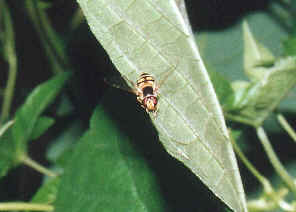
- Simosyrphus grandicornis, body length 10mm.
- The above picture shows another species of Hover Flies.
- Drone fly, Rat-tailed Maggot
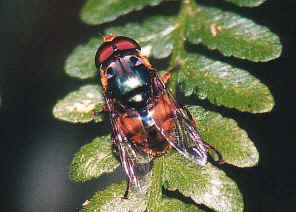
- Eristalis tenax, body length 8mm.
- We found many of them in Yugarapul Park during early summer. The Dronefly in appearance bears a close resemblance to a honeybee. The larva has a long thin tail, thus, called a Rat-tailed Maggot. The rat-tailed maggot usually breeds in drains, sewage pools, and other stagnant water. This Drone fly is believed an introduced species to Australia.
- Native Drone Fly


- Eristalinus sp., body length 10mm
- Picture taken in Wishart Outlook along Bulimba Creek during a very hot day in late summer. The fly was resting on a Acacia leaf. The fly produces a loud buzz similar to bee.
- Drone Fly
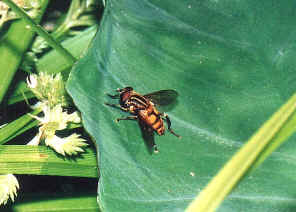

- Eristalinus sp., , body length 10mm
- We often found this wasp-mimic fly in bush during early summer. It has dark colour wings, yellow and black bands body and large eyes, the warning colours just good enough to mimic a wasp. But it has short antenna, one pair of wings and those tell it is a fly.

- Small Hoverfly
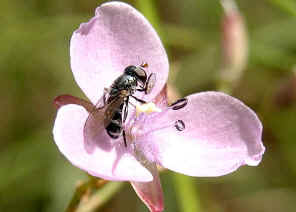

- Eumerus sp., body length 6mm
- This hoverfly is relatively smaller. We saw them only once in Alexandra Hill during late summer. We saw some of them feeding on the pink wild flowers Grass Lily, ( also known as Slug Herb or Blue Murdannia, Murdannia graminea, family Campanulaceae). This flower is common in Alexandra Hill.
- Wasp-mimicking Hoverfly
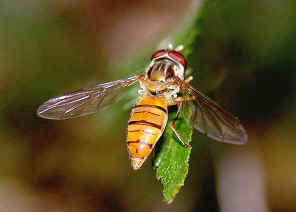
- ? sp., body length 10 mm
- We found many of them in Yugarapul Park during early summer. This is a small hover fly mimicking wasp. This fly even have the narrow waist.
- Unknown Hoverfly 1

- Eumerus sp.? body length 15mm
- Please advise if you recognize any of them. Thank you.
